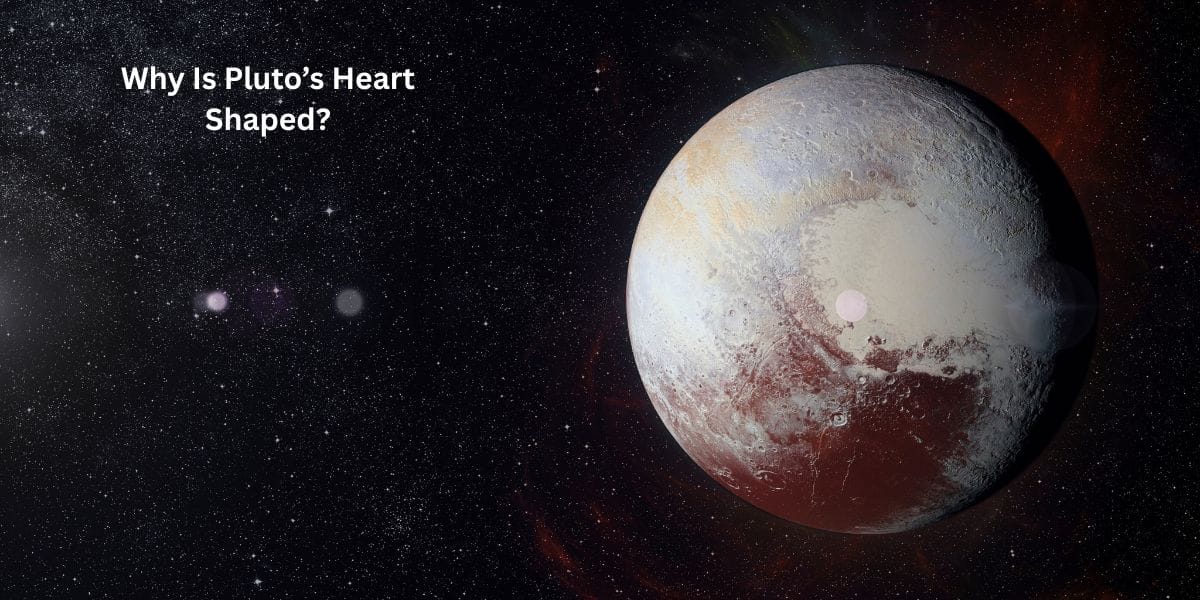Have you ever seen a picture of Pluto and noticed a big, bright heart on its surface? This heart-shaped feature is one of the most famous things about Pluto. But how did it get there? Is it really a heart, or just a funny-shaped patch?
Pluto is a small, icy world far away from the sun. Even though it’s no longer called a planet, it’s still full of surprises. The heart shape was discovered when a spacecraft named New Horizons flew by Pluto in 2015. The pictures it took amazed scientists and space lovers everywhere.
So, what caused this giant heart on Pluto? Let’s find out!
What Is Pluto’s Heart Made Of?
Pluto’s heart is not like a Valentine’s Day heart. It’s actually a huge area made of ice and frozen gases. The left side of the heart (the bigger part) is called Sputnik Planitia. It’s a deep, smooth plain filled with nitrogen ice.
- Nitrogen ice is like super-cold snow. On Earth, we have water ice, but Pluto is so cold that even gases freeze!
- The right side of the heart is made of different ices and mountains.
- The heart is about 1,000 miles (1,600 km) wide—bigger than some countries!
This heart isn’t just pretty—it also affects Pluto’s weather. The ice slowly moves, like a glacier, shaping the land over time.
How Did Pluto’s Heart Form?
Scientists think the heart shape was created by a giant impact long ago. A big space rock might have crashed into Pluto, leaving a huge dent. Over time, the dent filled with ice, making the smooth, heart-shaped area we see today.
- The heart sits near Pluto’s equator, where sunlight is strongest.
- The ice there sublimates (turns from solid to gas) and refreezes, keeping the heart bright.
- Winds on Pluto blow the ice around, making the heart look even smoother.
This heart is not just a random shape—it tells us a lot about Pluto’s history!
Why Is Pluto’s Heart So Bright?
Pluto’s heart is one of the brightest spots on its surface. The reason? Fresh ice!
- The ice in the heart is newer than the darker areas around it.
- Sunlight reflects off the smooth ice, making it shine.
- Other parts of Pluto are covered in old, dark material, making the heart stand out even more.
Think of it like snow—fresh snow is bright white, but old snow gets dirty and dark. Pluto’s heart is like a giant patch of fresh snow that never melts!
Does Pluto’s Heart Affect Its Climate?
Yes! The heart-shaped region actually changes Pluto’s weather.
- The ice in the heart evaporates and condenses with temperature changes.
- This creates a thin atmosphere around Pluto for a short time.
- Winds carry the ice particles, creating patterns on the surface.
It’s like how water on Earth forms clouds and rain—just much, much colder!
Could Pluto’s Heart Ever Disappear?
Not anytime soon! Pluto is so cold that the ice in its heart stays frozen.
- The heart has been there for millions of years.
- Changes happen very slowly because Pluto is far from the sun.
- Even if some ice evaporates, more freezes again, keeping the heart shape.
So, Pluto’s heart isn’t going anywhere—it’s here to stay!
Conclusion
Pluto’s heart is one of the most amazing features in our solar system. It’s made of ice, shaped by impacts, and even changes Pluto’s weather! This heart isn’t just for show—it helps scientists understand how small, icy worlds like Pluto work.
Next time you see a picture of Pluto, remember: that heart is more than just a shape. It’s a frozen wonder millions of miles away!
📌 Frequently Asked Questions
Is Pluto’s heart really a heart?
No, it just looks like one! It’s a large area of ice shaped like a heart.
What is the heart on Pluto called?
The left side is called Sputnik Planitia, named after Earth’s first satellite.
How big is Pluto’s heart?
It’s about 1,000 miles (1,600 km) wide—bigger than Texas!
Why is Pluto’s heart so bright?
Because it’s covered in fresh, reflective ice that sunlight bounces off.
Does Pluto have weather because of its heart?
Yes! The ice in the heart affects Pluto’s thin atmosphere and winds.
Could humans ever land on Pluto’s heart?
Not with current technology. Pluto is too far, too cold, and has almost no air to breathe.
Is Pluto’s heart the only heart in space?
No! Other planets and moons have heart-shaped features, but Pluto’s is the most famous.
How cold is Pluto’s heart?
Around -375°F (-225°C)—colder than Antarctica!
Will Pluto’s heart last forever?
It will stay for a very long time because Pluto is so cold and far from the sun.
Why did Pluto lose its planet status?
Because it’s small and shares its orbit with other icy objects. But it’s still a fascinating world!
